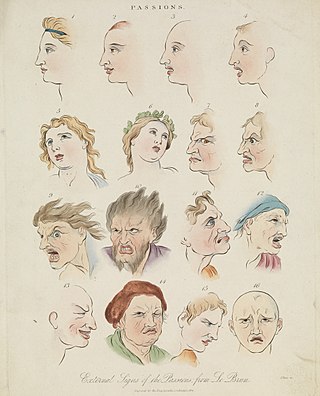
An emoticon, short for emotion icon, is a pictorial representation of a facial expression using characters—usually punctuation marks, numbers, and letters—to express a person's feelings, mood, or reaction, without needing to describe it in detail.

Emotions are mental states brought on by neurophysiological changes, variously associated with thoughts, feelings, behavioral responses, and a degree of pleasure or displeasure. There is no scientific consensus on a definition. Emotions are often intertwined with mood, temperament, personality, disposition, or creativity.
Flaming, also known as roasting, is the act of posting insults, often including profanity or other offensive language, on the internet. Flaming is distinct from trolling, which is the act of someone causing discord online or in person. Flaming emerges from the anonymity that Internet forums provide for users and which allow them to act more aggressively. Anonymity can lead to disinhibition, which results in the swearing, offensive, and hostile language characteristic of flaming. Lack of social cues, less accountability of face-to-face communications, textual mediation and deindividualization are also likely factors. Deliberate flaming is carried out by individuals known as flamers, which are specifically motivated to incite flaming. These users specialize in flaming and target specific aspects of a controversial conversation.
Affective computing is the study and development of systems and devices that can recognize, interpret, process, and simulate human affects. It is an interdisciplinary field spanning computer science, psychology, and cognitive science. While some core ideas in the field may be traced as far back as to early philosophical inquiries into emotion, the more modern branch of computer science originated with Rosalind Picard's 1995 paper on affective computing and her book Affective Computing published by MIT Press. One of the motivations for the research is the ability to give machines emotional intelligence, including to simulate empathy. The machine should interpret the emotional state of humans and adapt its behavior to them, giving an appropriate response to those emotions.
A facial expression is one or more motions or positions of the muscles beneath the skin of the face. According to one set of controversial theories, these movements convey the emotional state of an individual to observers. Facial expressions are a form of nonverbal communication. They are a primary means of conveying social information between humans, but they also occur in most other mammals and some other animal species.
Computer-mediated communication (CMC) is defined as any human communication that occurs through the use of two or more electronic devices. While the term has traditionally referred to those communications that occur via computer-mediated formats, it has also been applied to other forms of text-based interaction such as text messaging. Research on CMC focuses largely on the social effects of different computer-supported communication technologies. Many recent studies involve Internet-based social networking supported by social software.
Virtual sex is sexual activity where two or more people gather together via some form of communications equipment to arouse each other, often by the means of transmitting sexually explicit messages. Virtual sex describes the phenomenon, no matter the communications equipment used.
Unconsciouscommunication is the subtle, unintentional, unconscious cues that provide information to another individual. It can be verbal l or it can be non-verbal. Some psychologists instead use the term honest signals because such cues are involuntary behaviors that often convey emotion whereas body language can be controlled. Many decisions are based on unconscious communication, which is interpreted and created in the right hemisphere of the brain. The right hemisphere is dominant in perceiving and expressing body language, facial expressions, verbal cues, and other indications that have to do with emotion but it does not exclusively deal with the unconscious.
Media richness theory, sometimes referred to as information richness theory or MRT, is a framework used to describe a communication medium's ability to reproduce the information sent over it. It was introduced by Richard L. Daft and Robert H. Lengel in 1986 as an extension of information processing theory. MRT is used to rank and evaluate the richness of certain communication media, such as phone calls, video conferencing, and email. For example, a phone call cannot reproduce visual social cues such as gestures which makes it a less rich communication media than video conferencing, which affords the transmission of gestures and body language. Based on contingency theory and information processing theory, MRT theorizes that richer, personal communication media are generally more effective for communicating equivocal issues in contrast with leaner, less rich media.
Expectancy violations theory (EVT) is a theory of communication that analyzes how individuals respond to unanticipated violations of social norms and expectations. The theory was proposed by Judee K. Burgoon in the late 1970s and continued through the 1980s and 1990s as "nonverbal expectancy violations theory", based on Burgoon's research studying proxemics. Burgoon's work initially analyzed individuals' allowances and expectations of personal distance and how responses to personal distance violations were influenced by the level of liking and relationship to the violators. The theory was later changed to its current name when other researchers began to focus on violations of social behavior expectations beyond nonverbal communication.

Social information processing theory, also known as SIP, is a psychological and sociological theory originally developed by Salancik and Pfeffer in 1978. This theory explores how individuals make decisions and form attitudes in a social context, often focusing on the workplace. It suggests that people rely heavily on the social information available to them in their environments, including input from colleagues and peers, to shape their attitudes, behaviors, and perceptions.
The hyperpersonal model is a model of interpersonal communication that suggests computer-mediated communication (CMC) can become hyperpersonal because it "exceeds [face-to-face] interaction", thus affording message senders a host of communicative advantages over traditional face-to-face (FtF) interaction. The hyperpersonal model demonstrates how individuals communicate uniquely, while representing themselves to others, how others interpret them, and how the interactions create a reciprocal spiral of FtF communication. Compared to ordinary FtF situations, a hyperpersonal message sender has a greater ability to strategically develop and edit self-presentation, enabling a selective and optimized presentation of one's self to others.
Social presence theory explores how the "sense of being with another" is influenced by digital interfaces in human-computer interactions. Developed from the foundations of interpersonal communication and symbolic interactionism, social presence theory was first formally introduced by John Short, Ederyn Williams, and Bruce Christie in The Social Psychology of Telecommunications. Research on social presence theory has recently developed to examine the efficacy of telecommunications media, including SNS communications. The theory notes that computer-based communication is lower in social presence than face-to-face communication, but different computer-based communications can affect the levels of social presence between communicators and receivers.

Facial electromyography (fEMG) refers to an electromyography (EMG) technique that measures muscle activity by detecting and amplifying the tiny electrical impulses that are generated by muscle fibers when they contract.
Affective haptics is the emerging area of research which focuses on the study and design of devices and systems that can elicit, enhance, or influence the emotional state of a human by means of sense of touch. The research field is originated with the Dzmitry Tsetserukou and Alena Neviarouskaya papers on affective haptics and real-time communication system with rich emotional and haptic channels. Driven by the motivation to enhance social interactivity and emotionally immersive experience of users of real-time messaging, virtual, augmented realities, the idea of reinforcing (intensifying) own feelings and reproducing (simulating) the emotions felt by the partner was proposed. Four basic haptic (tactile) channels governing our emotions can be distinguished:
- physiological changes
- physical stimulation
- social touch
- emotional haptic design.
Social cues are verbal or non-verbal signals expressed through the face, body, voice, motion and guide conversations as well as other social interactions by influencing our impressions of and responses to others. These percepts are important communicative tools as they convey important social and contextual information and therefore facilitate social understanding.
Joseph B. Walther is the Mark and Susan Bertelsen Presidential Chair in Technology and Society and the Director of the Center for Information Technology & Society at the University of California, Santa Barbara. His research focuses on social and interpersonal dynamics of computer-mediated communication, in groups, personal relationships, organizational and educational settings. He is noted for creating social information processing theory in 1992 and the hyperpersonal model in 1996.
Emotion perception refers to the capacities and abilities of recognizing and identifying emotions in others, in addition to biological and physiological processes involved. Emotions are typically viewed as having three components: subjective experience, physical changes, and cognitive appraisal; emotion perception is the ability to make accurate decisions about another's subjective experience by interpreting their physical changes through sensory systems responsible for converting these observed changes into mental representations. The ability to perceive emotion is believed to be both innate and subject to environmental influence and is also a critical component in social interactions. How emotion is experienced and interpreted depends on how it is perceived. Likewise, how emotion is perceived is dependent on past experiences and interpretations. Emotion can be accurately perceived in humans. Emotions can be perceived visually, audibly, through smell and also through bodily sensations and this process is believed to be different from the perception of non-emotional material.

Face-to-face interaction is social communication carried out with other present individuals without any mediating technology. It is defined as the mutual influence of individuals’ direct physical presence with their body language and verbal language. It is one of the basic elements of a social system, forming a significant part of socialization and experience throughout an individual's lifetime. It is also central to the development of groups and organizations composed of those individuals. Face-to-face interaction not only allows people to communicate more directly, but has been shown to improve mental health and can reduce various mental illnesses, most commonly, depression and anxiety.
The study of the relationship between gender and emotional expression is the study of the differences between men and women in behavior that expresses emotions. These differences in emotional expression may be primarily due to cultural expectations of femininity and masculinity.






